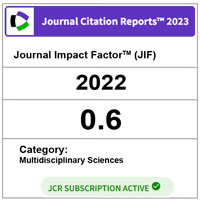Modeling the Impact of Pollution on Sea Turtles
DOI:
https://doi.org/10.11113/mjfas.v19n4.2913Keywords:
Mathematical model, pollution, sea turtles, stability analysisAbstract
Human activities are currently threatening sea turtles at all life stages, both on nesting beaches and at sea. The debris and toxic waste dumped on the coast or at sea pollutes the sea and puts marine life in danger. In recent years, the number of global turtle population have noticeably decreased, and this is largely due to plastic pollution. However, how the sea pollution affects the sea turtles’ populations is not fully understood. Therefore, in this study, using the mathematical model, we will investigate the impact of pollution on sea turtle population. The model system is analyzed using standard mathematical techniques, including positivity of solutions and stability analysis. Our findings showed that there are two possible equilibrium points (i.e. steady-state solutions) for the model proposed, in which the stability analysis showed that only one of the solutions is asymptotically stable. Thus, the conditions of stability for both equilibrium points were also derived analytically based on their eigenvalues. As for the numerical simulations, the parameter of contamination rate is varied to investigate the effect of pollution on the population of sea turtles. The results suggested that if the contamination rate is high, then the population of sea turtles are expected to decrease and extinct approximately within 10 years. The comparison of survival and extinction of sea turtles are shown using the time series plots.
References
WWF. (2018). Plastic pollution is killing sea turtles: Here's how. (2018, October 0). Retrieved from WWF: https://www.wwf.org.au/news/blogs/plastic-pollution-is-killing-sea-turtles-heres-how#gs.4gif6i.
Tomas, J., Guitart, R., Mateo, R., & Raga, J. (2002). Marine debris ingestion in loggerhead sea turtles, Caretta caretta, from the western Mediterranean. Marine Pollution Bulletin, 44, 211-216.
Derraik, J. G. (2002). The pollution of the marine environment by plastic debris: a review. Marine Pollution Bulletin, 842-852.
Bugoni, L., Krause, L., & Petry, M. V. (2001). Marine debris and human impacts on sea turtles in Southern Brazil. Marine Pollution Bulletin, 42, 1330-1334.
Gramentz, D. (1988). Involvement of loggerhead turtle with the plastic, metal, and hydrocarbon pollution in the Central Mediterranean. Marine Pollution Bulletin, 19, 11-13
Bjorndal, K. A., Bolten, A. B., & Lagueux, C. J. (1994). Ingestion of marine debris by juvenile sea turtles in Coastal Florida habitats. Marine Pollution Buletin, 28, 154-158.
Mascarenhas, R., Santos, R., & Zeppelini, D. (2004). Plastic debris ingestion by sea turtle in Paraiba, Brazil. Marine Pollution Bulletin, 49, 354-355.
Tourinho, P. S., Ivar do Sul, J. A., & Fillmann, G. (2010). Is marine debris ingestion still a problem for the coastal marine biota of southern Brazil? Marine Pollution Bulletin, 60, 369-401
Guebert-Bartholo, F. M., Barletta, M., Costa, M. F., & Monteiro-Filho, E. L. (2011). Using gut contents to assess foraging patterns of juvenile green turtles Chelonia mydas in the Paranagua' Estuary, Brazil. Endangered Species Research, 13, 131-143.
Lazar, B., & Gracan, R. (2011). Ingestion of marine debris by loggerhead sea turtles, Caretta caretta, in the Adriatic Sea. Marine Pollution Bulletin, 62, 43-47.
Campani, T., Baini, M., Giannetti, M., Cancelli, F., Mancusi, C., Serena, F., . . . Fossi, M. C. (2013). Presence of plastic debris in loggerhead turtle stranded along the Tuscany coasts of the Pelagos Sanctuary for Mediterranean Marine Mammals (Italy). Marine Pollution Bulletin, 74, 225-230.
Hoarau, L., Ainley, L., Jean, C., & Ciccione, S. (2014). Ingestion and defecation of marine debris by loggerhead sea turtles, Caretta caretta, from by-catches in the South-West Indian Ocean. Marine Pollution Buletin.
Wilcox, C., Puckridge, M., Schuyler, Q. A. (2018). A quantitative analysis linking sea turtle mortality and plastic debris ingestion. Sci Rep., 8, 12536
Prampramote, J., Boonhoh, W., Intongead, S., Sakornwimol, W., Prachamkhai, P., Sansamur, C., Hayakijkosol, O., and Wongtawan, T. (2022). Association of ocean macroplastic debris with stranded sea turtles in the Central Gulf of Thailand. Endangered Species Research, 47, 333-343
Dubey, B., & Narayanan, A. S. (2010). Modelling effects of industrialization, population and pollution on a renewable resource. Nonlinear Analysis: Real World Applications, 2833-2848.
Shukla, J. B., Misra, A. k., & Chandra, P. (2007). Mathematical modelling of the survival of a biological species in polluted water bodies. Differential Equation and Dynamical Systems,15, 209-230.
Waghmare, R. V., & Kiwne, S. B. (2017). Mathematical modeling of disposal of pollutant in rivers. International Journal of Computational and Applied Mathematics, 835-842.
Siddiqua, S., Chaturvedi, A., & Gupta, R. (2019). A review-mathematical modelling on water pollution and its effect on aquatic species. Advances in Applied Mathematics, 29-32.
Maystruk, V., & Abdella, K. (2011). Modelling the effects of poluution on a population and a resource in a polluted environment. ISRN Applied Mathematics, 1-31.
Sharma, S., & Samanta, G. P. (2013). Mathematical analysis of a single-species population model in a polluted environment with discrete time delays. Journal of Mathematics, 1-18.
Naresh, R., Sundar, S., & Sharma, D. (2014). Modeling the effect of toxicant on plant biomass with time delay. International Journal of Nonlinear Science, 254-267.
Dubey, B., Raw, S. N., Hussain, J., & Upadhyay, R. (2015). Modelling the effect of pollution on biological species: A socioecological problem. Computational Ecology and Software, 152-174.
Jyotsna, K., & Tandon, A. (2017). A mathematical model to study the impact of mining activities and pollution on forest resources and wildlife population. Journal of Biological Systems, 1-24.
Mohd Roslan, U. A., Jailani, M. S. O., & Mohd Uzair Rusli, M. U. (2019). Stability analysis for the dynamics of new sea turtle-human interaction model. Journal of Advanced in Dynamical & Control Systems, 11(12), 171-177.
Saifuddin, M., Sasmal, S. K., Biswas, S., Sarkar, S., Alquran, M., & Chattopadhyay, J. (2016). Effect of emergent carrying capacity in an eco‐epidemiological system. Mathematical Methods in the Applied Sciences, 39(4), 806-823.
Downloads
Published
Issue
Section
License
Copyright (c) 2023 Ummu Atiqah Mohd Roslan, Fatimah Noor Harun

This work is licensed under a Creative Commons Attribution-NonCommercial 4.0 International License.







